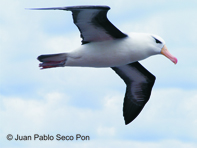From where and when did ACAP-listed species get their names? We start with the general terms albatross, petrel and shearwater.
Albatross
Accounts of the etymology of the word "albatross" do not all exactly agree, but you should get the main idea from the following two on-line quotes.
"Some English researchers think that the origin may be ultimately Greek kados meaning jar into Arabic al qadus a bucket. They relate that behind the relation of the two ideas that come from an irrigation bucket, which may have looked like a pelican's beak." (click here).
"Probably from Spanish or Portuguese alcatraz "pelican" (16c.), perhaps derived from Arabic al-ghattas "sea eagle" [Barnhart]; or from Port. alcatruz "the bucket of a water wheel" [OED], from Arabic al-qadus "machine for drawing water, jar" (from Gk. kados "jar"), in reference to the pelican's pouch (cf. Arabic saqqa "pelican," lit. "water carrier")." (click here).
The long Moorish occupation of the Iberian Peninsula from the 9th to the 15th centuries resulted in the Arabic word becoming alcatraz in Spanish and Portuguese - and being used to refer to the North Atlantic Gannet as well to the pelican.
Once sailing vessels started to venture into southern latitudes the word was used to refer to albatrosses, which not occurring in the North Atlantic would have been unfamiliar birds to European explorers and thus in wont of a name. A good account of the slow transference of alcatraz to albatross is given by Lance Tickell in his book Albatrosses. He shows that different English explorer texts used allcatrazes as early as 1638, albetrosses in 1673, algatrosses in 1697, alcatrasses in 1700, albitrosses in 1719 and alcatrace as late as 1779.
What is generally agreed is that albatross does not come from albus, Latin for white.

A Black-browed Albatross at sea: the first albatross species to be seen by a European explorer heading south in the Atlantic?
Petrel
The word "petrel" ultimately comes from the Latin petrus, itself from the Greek petra, meaning a rock or large stone and the original source of the name of Saint Peter, an early Christian leader and one of the twelve apostles (click here).
The derivation is believed to come from the way some storm-petrels patter their feet on the sea surface while foraging, thus giving an appearance of walking on water. In the Christian Bible Matthew describes Peter walking on water, but sinking when his faith wavered:
And Peter answered him, "Lord, if it is you, command me to come to you on the water." He said, "Come." So Peter got out of the boat and walked on the water and came to Jesus. But when he saw the strong wind, he was afraid, and beginning to sink he cried out, "Lord, save me." Jesus immediately reached out his hand and took hold of him, saying to him, "O you of little faith, why did you doubt?" (Matthew 14: 28-31.).
Shearwater
Shearwaters (genera Calonectris and Puffinus) are so named because of their habit of flying with the tip of one wing just cutting (or shearing) the sea surface, most easily seen on calm days. Use of this name has been traced back to the 17th Century.
Future news stories will look at the etymology and derivations of some of the more intriguing common and scientific names of ACAP-listed albatrosses, petrels and shearwaters.
Reference:
Tickell, W.L.N. 2000. Albatrosses. Mountfield: Pica Press.
John Cooper, ACAP Information Officer, 19 June 2012

 English
English  Français
Français  Español
Español